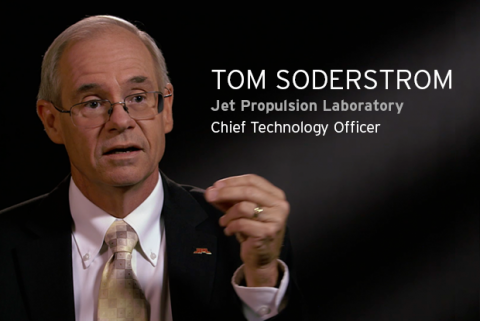How to Adopt Technology for The Next IT Decade
by Tom Soderstrom, IT Chief Technology Officer, Jet Propulsion Laboratory
With the pace of technology change being what it is, I like to say an IT decade is now three years long, and it’s shrinking. Whether you buy this proposition or not, the important thing is to get a handle on what technologies are coming soon to your enterprise and how to incorporate them into your next generation of applications and services.
The previous IT decade consisted, by my count, of nine trends: The Pervasive Cloud, Consumer Driven IT, Eco Friendliest, Refocused Cyber Security, You've Got Apps, Immersive Visualization and Interaction, Extreme Collaboration Made Simple, Big Data and Human Behavior. The first four trends already have become cornerstones of everything we do at Jet Propulsion Labs; the last five are evolving in this direction.
When our team looks at the next IT decade we see one megatrend, which we call SMACK: Social, Mobile, Analytics, Cloud and Key disruptors. Each of these is a trend, but each is also part of the larger, interrelated trend we call SMACK.
By being included in SMACK, the trends we have chosen make themselves into a very simple checklist. That means when someone in your organization is building an application or service, or buying an application or service, you can ask, “Have you considered SMACK?”
Here is how the list works in action.
Social. Social includes social networking moving into the enterprise. We can learn a lot from how apps and services are funded, built, spread, changed, and socialized in Internet space. It also includes crowdsourcing. For us that means how we can attract a group of new people to work on our problem – and, given the stiff competition for IT talent, how we attract people to work at JPL. It also means crowd-funding, crowd-development (aka hackathons), crowd-ideation, etc. It also includes video conferencing from any device to any device. So in developing or buying an application or service, we will ask whether it draws on Social in a productive or innovative way.
Mobile. Mobile means that will take a mobile-first point of view. If you look at today’s start-ups, they are making the switch from building for the web first to building for mobile first. In the next IT decade your smartphone will become the heart of your computing. You already can talk to it of course, using tools like SIRI, or use a gesture interface as you do with Microsoft Kinect on the Xbox, but what will come next? Mobile will also include wearable computing, which includes smart watches, smart rings, smart armbands and so on. Other trends that will be important include Augmented Reality and Bring Your Own Experience (a super set of BYOD).
Analytics. Analytics is really the actionable part of Big Data, which is why it makes innate sense to people even as they manage the hugely hyped Big Data world. In the SMACK checklist you ask your development team whether this thing you’re building collects and makes available enough data so you can measure its success. Do you have a way to get the numbers and the metrics to implement automated prescriptive analytics? How is it handling structured data and/or unstructured data? Can you visualize the data in an exciting and insightful way? Our goal is to create a self-service analytics environment where everyone can combine different types of data and interact and analyze it to gain new insights.
Cloud. Cloud, the fourth part of SMACK, begs the question of where you are going to run the service or application you’re building or buying. Will it run in your private cloud, in your traditional IT data center, in a public cloud, in a hybrid cloud, or in all of them? Perhaps you simply do a prototype in a public cloud and then decide based on the customer feedback and engagement?
Key Disruptors. Key Disruptors are the final part of SMACK. There are many questions to ask here as we look at new technology. For example, will this technology change our lives? If we don’t get ahead of it, will it disrupt us? If we do get ahead of it, will it become a competitive advantage? Cloud computing and the iPhone were both key disruptors and we got ahead of them at JPL, to great advantage. A current key disruptor at JPL is 3D printing: we already are using it as a brainstorming tool and seeing tremendous benefits. Augmented reality is another where we already see tremendous benefits and potential.
Finally, remember that any application or service you consider – and anything that will succeed in the next IT decade – must be simple. That means simple to understand, simple to use and simple to lose: in other words, if it doesn’t work out, you can move on and do something else without few consequences. Technology for the coming IT decade also needs to be self-service so people can get to it at any time.
With the previous decade of nine IT trends winding down, it’s nice to be able to focus on one. We learned a lot from the Human Behavior trend and have incorporated that into SMACK. One key item is that it’s not enough to simply hand end users the new technology. Instead, you need to prototype it with them and provide an IT Concierge to show them how to use it. As you consider what to prototype and what to pilot in your own enterprise, consider the SMACK checklist, so you can decide, “Is this a fad or something worth a lot more attention?” Especially if it is a Key disrupter, provide an IT Concierge and you will see a tremendous return on that investment.
Tom Soderstrom is Chief Technology and Innovation Officer, Office of the CIO at the Jet Propulsion Laboratory (JPL) in Los Angeles, CA and a member of the Enterprisers Editorial Board. JPL is the lead U.S. center for robotic exploration of the solar system and conducts major programs in space-based Earth sciences. JPL currently has several dozen aircraft and instruments conducting active missions in and outside of our solar system




